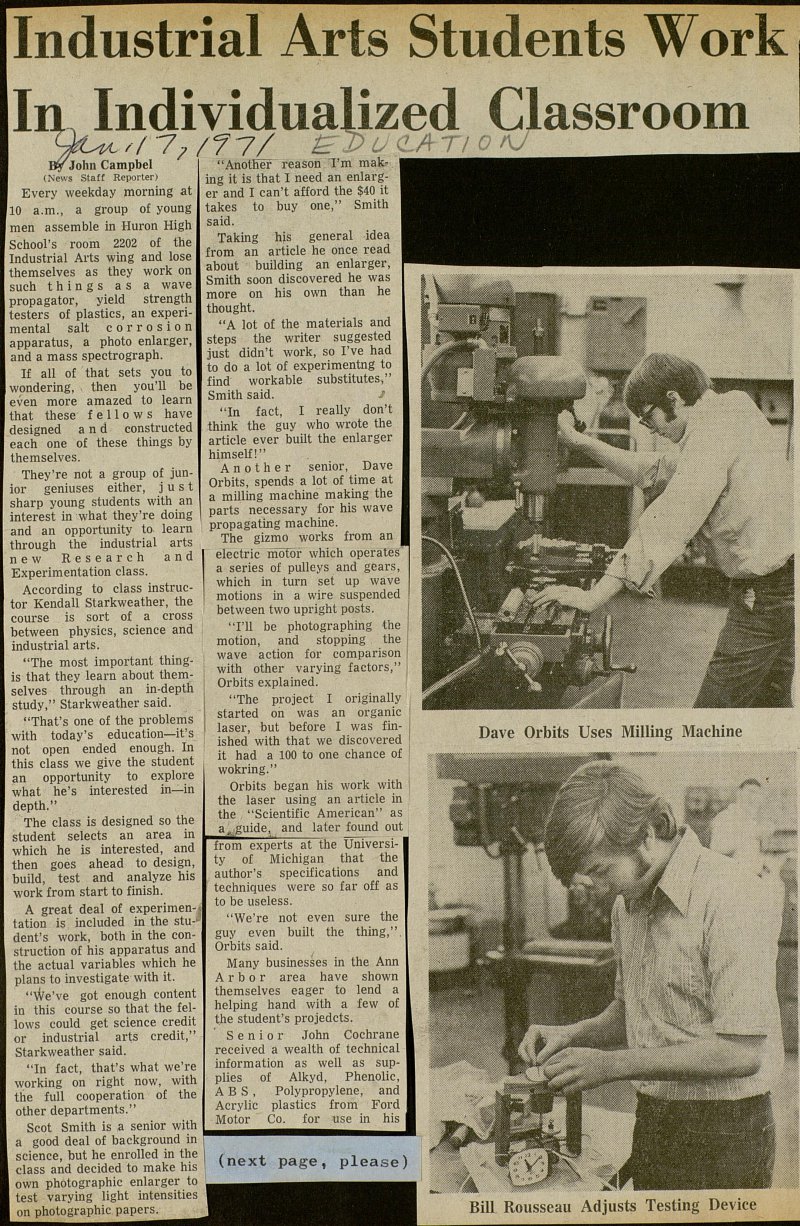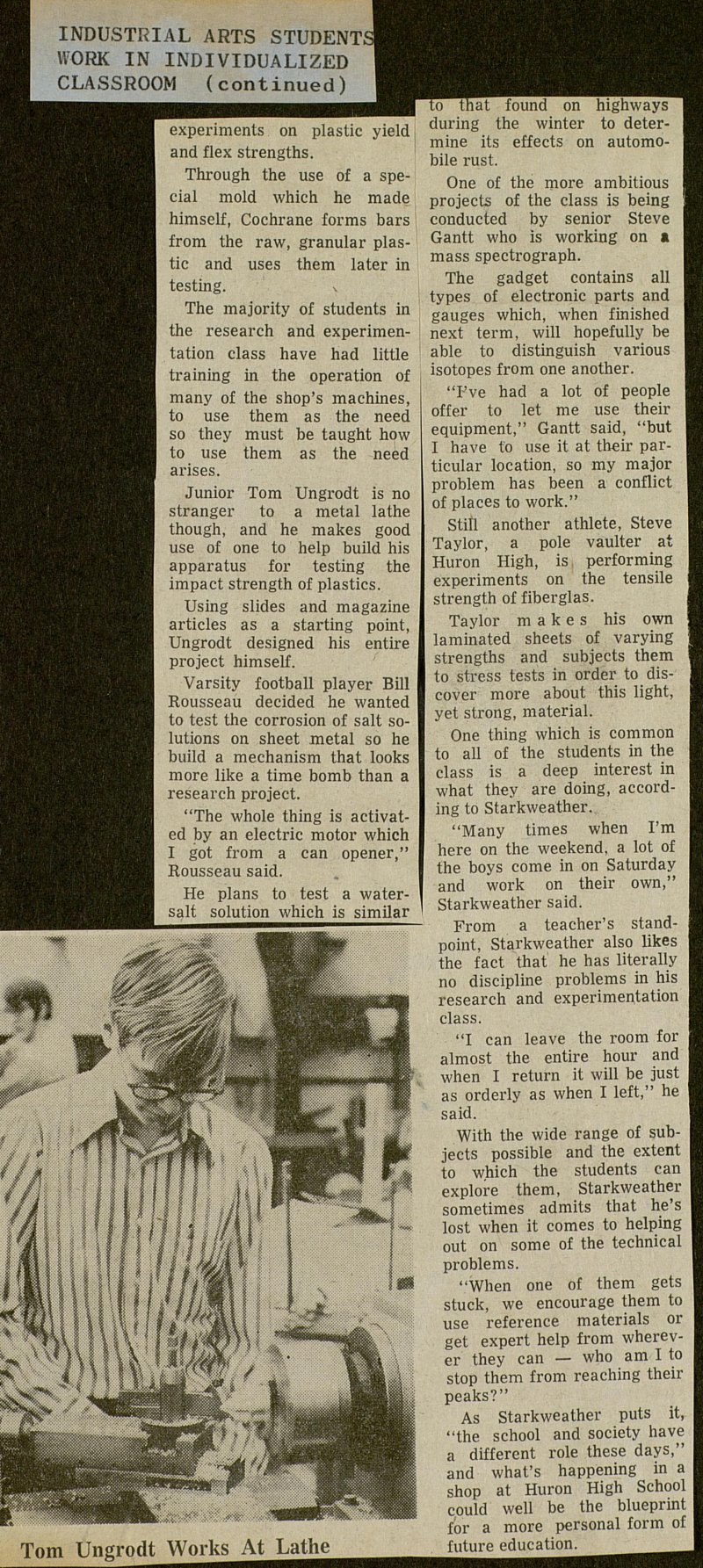Industrial Arts Students Work In Individualized Classroom


Every weekday morning at 10 a.m., a group of young men assemble in Huron High School's room 2202 of the Industrial Arts wing and lose themselves as they work on such things as a wave propagator, yield strength testers of plastics, an experimental salt corrosión apparatus, a photo enlarger, and a mass spectrograph. If all of that sets you to wondering, then you'll be even more amazed to learn that these f e 1 1 o w s have designed and constructed each one of these things by themselves. They're not a group of junior geniuses either, j u s t sharp young students with an interest in what they're doing and an opportunity to learn through the industrial arts new Research and Experimentation class. According to class instructor Kendall Starkweather, the course is sort of a cross between physics, science and industrial arts. "The most important thingis that they learn about themselves through an in-depth study," Starkweather said. "That's one of the problems with today's education- it's not open ended enough. In this class we give the student an opportunity to explore what he's interested in- in depth." The class is designed so the student selects an area in which he is interested, and then goes ahead to design, build, test and analyze his work from start to finish. A great deal of experimen- tation is included in the stu-dent's work, both in the construction of his apparatus and the actual variables which he plans to investígate with it. "We've got enough content in this course so that the fellows could get science credit or industrial arts credit," Starkweather said. "In fact, that's what we're working on right now, with the full cooperation of the other departments." Scot Smith is a senior with a good deal of background in science, but he enrolled in the I class and decided to make his own photographic enlarger to test varying light intensities on photographic papers. "AnotKef reason Tm I ing it is that I need an enlarger and I can't afford the $40 it takes to buy one," Smith said. Taking his general idea from an article he once read about building an enlarger, Smith soon discovered he was more on his own than he thought. "A lot of the materials and steps the writer suggested just didn't work, so I've had to do a lot of experimentng to find workable substitutes," Smith said. "In fact, I really don't think the guy who wrote the article ever built the enlarger himself!" A n o t h e r senior, Dave Orbits, spends a lot of time at a milling machine making the parts necessary for his wave propagating machine. The gizmo works from an electric motor which operates a series of pulleys and gears, which in turn set up wave motions in a wire suspended between two upright posts. 'Til be photographing the motion, and stopping the wave action for comparison with other varying factors," Orbits explained. "The project I originally started on was an organic laser, but before I was finished with that we discovered it had a 100 to one chance of wokring." Orbits began his work with the laser using an article in the "Scientific American" as aguide, and later found out from experts at the University of Michigan that the author's specifications and techniques were so far off as to be useless. "We're not even sure the guy even built the thing,". Orbits said. Many businesses in the Ann A r b o r area have shown themselves eager to lend a helping hand with a few of the student's projedcts. Senior John Cochrane received a wealth of technical information as well as supplies of Alkyd, Phenolic, ABS, Polypropylene, and Acrylic plastics from Ford Motor Co. for use in his (next page, please) INDUSTRIAL ARTS STUDENTE WORK IN INDIVIDUALIZED ' CLASSROOM (continued) expenments on plastic yield and flex strengths. Through the use of a special mold which he made himself, Cochrane forms bars from the raw, granular plastic and uses them later in testing. -. The majority of students in the research and experimentation class have had little training in the operation of many of the shop's machines, to use them as the need so they must be taught how to use them as the need arises. Junior Torn Ungrodt is no stranger to a metal lathe though, and he makes good use of one to help build his apparatus for testing the impact strength of plastics. Using slides and magazine articles as a starting point, Ungrodt designed his entire project himself. Varsity football player Bill Rousseau decided he wanted to test the corrosión of salt solutions on sheet metal so he build a mechanism that looks more like a time bomb than a research project. "The whole thing is activated by an electric motor which I got from a can opener," Rousseau said. He plans to test a watersalt solution which is similar Tö that found on highways I during the winter to deterI mine its effects on automoI bile rust. One of the more ambitious I projects of the class is being ] conducted by senior Steve I Gantt who is working on I mass spectrograph. The gadget contains all I types of electronic parts and I gauges which, when finished I next term, will hopefully be I able to distinguish various I isotopes from one another. 'Tve had a lot of people I offer to let me use their I equipment," Gantt said, "but I I have to use it at their particular location, so my major I problem has been a conflict I of places to work." Still another athlete, Steve Taylor, a pole vaulter at I Huron High, is performing I experiments on the tensile j strength of fiberglas. 1 Taylor makes his own laminated sheets of varying j strengths and subjects them I to stress tests in order to discover more about this light, yet strong, material. One thing which is common to all of the students in the I class is a deep interest in what they are doing, I ing to Starkweather., "Many times when I'm here on the weekend, a lot of the boys come in on Saturday I and work on their own," Starkweather said. From a teacher's I point, Starkweather also likes I the fact that he has literally I no discipline problems in his I research and experimentation I class. "I can leave the room for I almost the entire hour and I when I return it will be just I as orderly as when I left," he I said. With the wide range of subjects possible and the extent to which the students can explore them, Starkweather sometimes admits that he's lost when it comes to helping out on some of the technical problems. "When one of them gets stuck, we encourage them to use reference materials or get expert help from wherever they can - who am I to stop them from reaching their peaks?" As Starkweather puts it, "the school and society have a different role these days," and what's happening in a shop at Huron High School c.ould well be the blueprint for a more personal form of